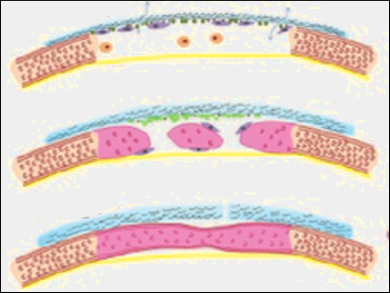Graphene-based materials could be useful for medical applications due to their good mechanical properties, their versatile morphology, and the possibility of chemical functionalization. However, there have been few examples of graphene materials specifically targeted and tested for such applications.
Derong Zou, Shanghai Jiao Tong University, China, Dan Li, Monash University, Australia, and colleagues have developed and tested a multilayered graphene hydrogel (MGH) membrane as a barrier membrane for guided bone regeneration (pictured). The membrane consists of multiple stacked chemically converted graphene (CCG) sheets. This roughly mimics the collagen fibers which combine with the inorganic hydroxyapatite in bones.
The team synthesized CCG by chemical reduction of a graphene oxide solution and filtered the resulting dispersion, which left the MGH membranes on the filter. The resulting material is strong, yet flexible, and nanochannels allow for the quick diffusion of nutrients. The researchers tested the membranes’ potential in guided bone regeneration, using skull defects in rats as a model. They compared the new material to titanium, which is commonly used to cover such bone defects.
The membranes successfully maintained osseous space, promoted early bone growth, and sped up mineralization compared to titanium. They adhered well to neighboring bone tissue and remained in place for eight weeks. The MGH membranes’ nanostructure resulted in improved osteoblast adhesion and apatite deposition. These results suggest that graphene-based membranes are promising candidates material for guided bone regeneration.
- Multilayered Graphene Hydrogel Membranes for Guided Bone Regeneration,
Jiayu Lu, Chi Cheng, Yu-Shi He, Chengqi Lyu, Yufei Wang, Jia Yu, Ling Qiu, Derong Zou, Dan Li,
Adv. Mater. 2016.
DOI: 10.1002/adma.201505375




